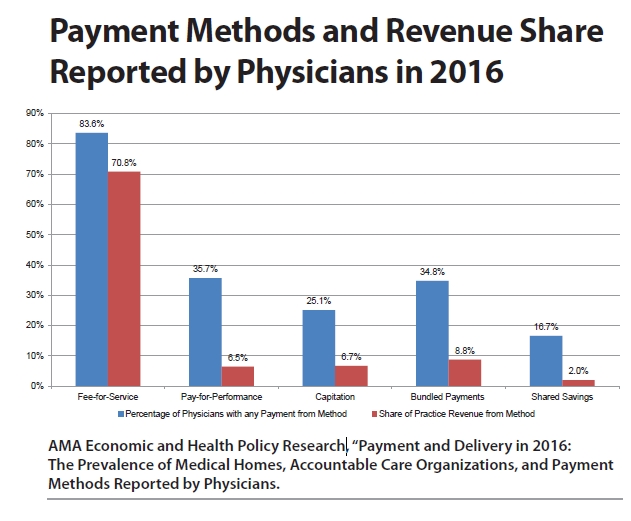But alternative payment methods are catching on
 Fee-for-service may be on a decline, but it maintains a strong grip on physician practices, at least for now. At the same time, participation in accountable care organizations and medical homes is on the upswing.
Fee-for-service may be on a decline, but it maintains a strong grip on physician practices, at least for now. At the same time, participation in accountable care organizations and medical homes is on the upswing.
Last fall, the American Medical Association’s Division of Economic and Health Policy Research released the results of its 2016 Physician Practice Benchmark Survey, which focuses on the practice arrangements and payment methodologies of physicians who take care of patients for at least 20 hours per week and who don’t work for the federal government. Benchmark surveys had previously been conducted in 2012 and 2014.
The first section of the report focuses on the extent to which physicians are in practices that belong to medical homes and Medicare, Medicaid, and commercial accountable care organizations (ACOs), as well as how that participation varies across practice attributes and how it has changed over time. The second section examines practice involvement in various payment models such as fee-for-service (FFS) and alternative payment models, including pay-for-performance, bundled payments, shared savings, and capitation.
Medical homes and ACOs
At the end of the first quarter of 2017, ACOs covered more than 10 percent of the U.S. population. ACOs have steadily grown, with a 2.2 million increase in covered lives and a net increase of 92 ACOs from the end of the first quarter in 2016 through the same period in 2017.
In 2016:
- 25.7 percent of physicians worked in practices that belonged to a medical home.
- 31.8 percent belonged to a Medicare ACO.
- 20.9 percent belonged to a Medicaid ACO.
- 31.7 percent belonged to a commercial ACO.
Overall, 44 percent of physicians were in practices that belonged to at least one type of ACO. Although earlier data on Medicaid and commercial ACO participation were not available, AMA found that participation in medical homes and Medicare ACOs was up slightly (by 2 to 3 percentage points) from 2014. Despite the increase in participation, awareness about participation remained the same as in 2014. For both medical homes and Medicare ACOs, about 25 percent of physicians did not know whether their practice was part of that particular model.
Payment methods
 The AMA study examined the percentage of physicians in practices that received fee-for-service and/or alternative payment models in 2016, trends in receiving payment from FFS from 2012 to 2016, and whether receiving FFS or alternative models appeared to be related to participation in medical homes and ACOs.
The AMA study examined the percentage of physicians in practices that received fee-for-service and/or alternative payment models in 2016, trends in receiving payment from FFS from 2012 to 2016, and whether receiving FFS or alternative models appeared to be related to participation in medical homes and ACOs.
Although FFS was the method reported most often by physicians (83.6 percent), receiving revenue through alternative models was not uncommon. In fact, 59.1 percent of physicians were in practices that received payment by at least one alternative payment model. Pay-for-performance and bundled payments had the highest participation rates of the alternative models examined – approximately 35 percent.
Despite participation in alternative payment models, the results show that such models accounted for a relatively small share of revenue. On average, pay-for-performance and capitation made up close to 7 percent of practice revenue, while bundled payments accounted for almost 9 percent and shared shavings only 2 percent. Thus, FFS dominated with the highest participation rate as well as a much higher share of practice revenue at an average of 70.8 percent.
As with their participation in medical homes and ACOs, some physicians were unaware of whether their practice received revenue through certain payment models. While only 10.6 percent of physicians were unaware of whether their practice received payment through FFS, the level of unawareness about receiving payment through alternative payment models ranged from around 20 percent for pay-for-performance, capitation, and bundled payments, to almost 30 percent for shared savings.
Source: AMA Economic and Health Policy Research, “Payment and Delivery in 2016: The Prevalence of Medical Homes, Accountable Care Organizations, and Payment Methods Reported by Physicians,” https://www.ama-assn.org/sites/default/files/media-browser/public/health-policy/prp-medical-home-aco-payment.pdf
